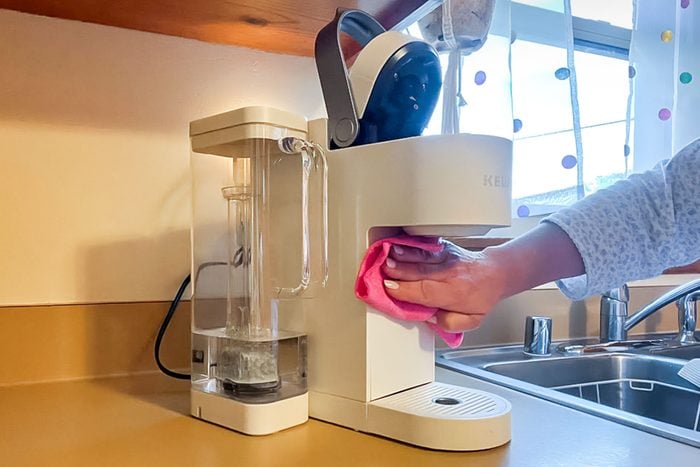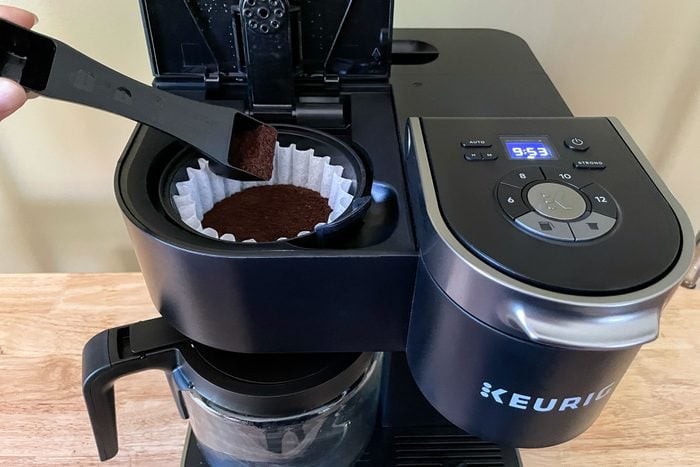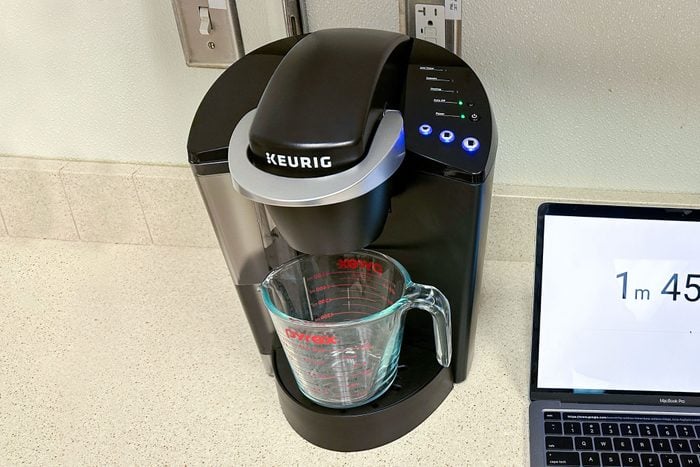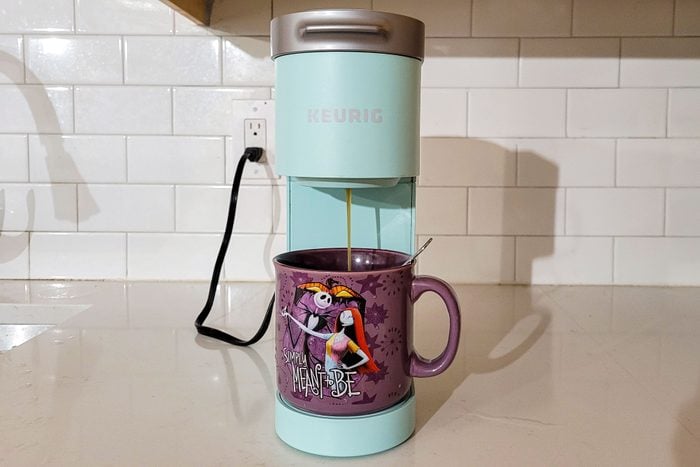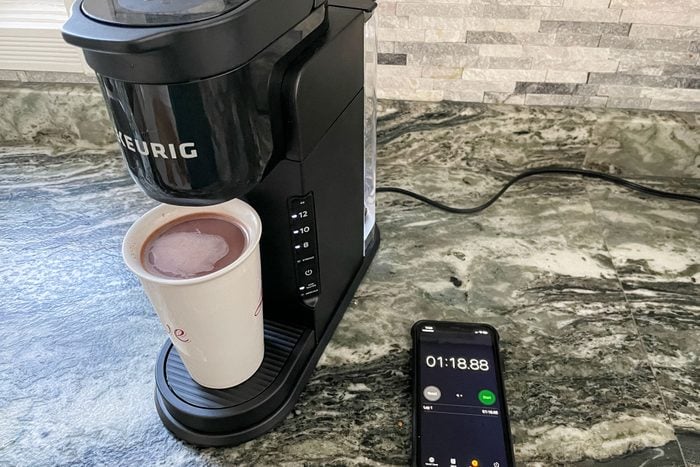What To Look for When Buying a Keurig Coffee Maker
We asked Riley Westbrook, co-founder of Valor Coffee, what to look for when shopping for single-serve coffee makers, and he said that one of the most important things to consider is how water flows through the pod.
“Many machines just blast it straight through the middle, thus skipping most of the coffee grounds, which often ends with a sour taste at the onset and a watery taste in the end,” he says. “Some of the best machines use multiple streams (or much wider spray heads) to cover the coffee better, and it does make a difference.” The Keurig K-Supreme listed above now features multi-stream technology.
Still, there are more factors to consider if you’re hunting for a new Keurig coffee maker. With so many options, it’s best first to decide what type of coffee you’re interested in. Are you a fan of plain black coffee sans cream and sugar? Or do you prefer something more specialized? Keurig has a long line of coffee makers, each with its own features and functions. Consider the size of the machine relative to your kitchen counter space.
Grind your own beans? You might opt for a single-serve coffee maker with a carafe. If brew capacity is important for your family, then get a Keurig with a larger water reservoir. A single college student might be OK with the ease and simplicity of the Keurig K-Mini. A seasoned coffee enthusiast would be better off with a Keurig with more programmable features like BrewID and the ability to serve hot coffee over ice. Here are some other factors (and more in-depth information) worth considering:
Model Type
Several Keurig models are available, but they typically fall into two classes: basic and advanced. Basic models are your average K-Cup brewers, designed to do little more than make a cup of coffee. Advanced models might have more features, like steaming capabilities and additional accessories. There are even some Keurigs that function both as standard drip coffee makers and K-Cup brewers. It’s important to decide whether you need something barebones or if you want all the bells and whistles before you shop.
Pod Variety and Availability
- K-Cup compatibility: If you use a Keurig coffee maker, make sure you buy K-Cups that are specifically Keurig-compatible. Otherwise, they won’t fit in your machine and will be entirely useless.
- Reusable pods: Reusable K-Cup pods allow you to put ground coffee into your Keurig (rather than buying premade pods from the store). This can increase your Keurig’s versatility, cost-friendliness and environmental friendliness.
Brew Sizes
Typically, a Keurig allows users to choose between five different brew sizes: 4 ounces, 6 ounces, 8 ounces, 10 ounces and 12 ounces. The more options, the more versatile the Keurig.
Water Reservoir Capacity
Keurig reservoirs range from 40 to 80 ounces and cannot be increased in size. The size of the reservoir determines how many cups of coffee you can make before refilling it.
User Interface
Most Keurigs have fairly similar displays and controls. It usually consists of a series of buttons to control the different brewing options (and the buttons may illuminate to show whether they’re currently active or what’s selected). Some may also include a digital clock interface.
Footprint and Design
Like other styles of coffee makers, Keurigs are daily-use devices, so you’ll probably want a dedicated spot on your kitchen counter for them. Remember that some are a good deal bigger than others (especially those with a greater array of features). We would not recommend moving your Keurig between uses, as they can be quite cumbersome, especially when the reservoir is full.
Energy Efficiency
Some Keurigs need to be shut off manually or unplugged)to cut off the power. Most, however, have an auto-shutdown feature that will automatically turn the machine off after two hours of idling (meaning without use). This feature can be turned off.
Maintenance and Cleaning
- Ease of cleaning: Keurigs are relatively easy to clean—or at least they’re not any more difficult than a standard coffee maker. Wiping them down between uses and cleaning up any lingering spills, splashes, etc., should be all you need. You may also want to do a deeper cleaning occasionally to ensure your Keurig stays in good working order. Additional features like foaming wands may require more comprehensive cleaning, as dairy buildup can promote bacterial growth.
- Descaling alerts: Some Keurigs have a descaling alert, meaning the machine will tell you when it is time for a deep cleaning (to remove the mineral buildup caused by the water in the reservoir). It’s important to heed these warnings and complete the required descaling when the alert goes off, as it could render your Keurig inoperable if you don’t.
Additional Features
- Milk frother: If you’re a fan of lattes and cappuccinos, prioritize getting a Keurig with an additional frothing wand. This allows you to foam milk for these specialty drinks. Ensure you’re also ready and willing to clean this feature often, as the dairy can gunk them up pretty badly.
- Water filter: Models including the Keurig Duo, Keurig Duo Plus, K-Supreme, K-Slim, K-Cafe, K-Elite, K-Select, K-Classic, K-Express and K145 support the use of compatible water filters. Some smaller Keurigs do not. This is not necessarily an essential feature, as you can filter your own water separately, but it can be a handy addition for those who want to skip an extra step.
Price and Warranty
- Cost: Compared to traditional drip coffee makers, Keurigs can seem quite expensive. They range from around $50 to over $1,000 for commercial models. It’s important to set your budget before you shop, but remember that the more expensive, the more bells and whistles there will be. Higher-priced models might also seem more convenient overall, but they could have added maintenance costs.
- Warranty: Pay close attention to the brand’s warranty information. This allows you to discern the kinds of damage that may be covered by the warranty, allowing you to get replacement parts or an entirely replaced machine.
KATIE BANDURSKI FOR TASTE OF HOME
How We Found the Best Keurig Coffee Makers
Sorting through the various Keurig models and identifying their similarities and differences can be dizzying, so we did it for you! For this comprehensive guide to the best Keurig coffee makers, we took into account online reviews, our own staffers’ experiences and rigorous firsthand testing.
We looked at packaging and delivery and any steps required before use. Then, we graded each Keurig coffee maker based on how loud, hot and well it brewed. Each tester evaluated their machine on size, craftsmanship, aesthetics and longevity.
Furthermore, we looked at features and functions and how they’d best serve different types of customers at various price points. Our experts gave the models that made this list the highest ratings for overall functionality and the ability to serve a delicious cup of coffee.
After six months, we also checked in with our testers to see if the machines were starting to show signs of wear, identify any issues and evaluate long-term performance.
Other Keurigs We Tested
- Keurig K-Mini Plus Coffee Maker: The K-Mini Plus is very similar to the K-Mini above. While the K-Mini Plus has a removable water tank and pod storage, it still has a single-cup water tank like the K-Mini. The K-Mini Plus also looks and functions almost identically to the K-Mini but retails at a higher price point. So, we recommend the K-Mini over the K-Mini Plus.
Mark Derse for Taste Recipes
- Keurig K-Iced Coffee Maker: Our Product Testing Manager, Annamarie Higley, liked how this machine performed with hot coffee. However, she was not impressed by the machine’s most standout function: the iced coffee option. She disliked how little iced coffee it produces. She also hardly thinks 150°F counts as chilled coffee. Our team of product testers recommends the K-Mini over the K-Iced Coffee Maker.
Annamarie Higley For Taste Recipes
- Keurig K-Slim Single-Serve Coffee Maker: The Keurig K-Slim is similar to both K-Minis but has a removable, multi-cup reservoir. It’s slim, so it’s suitable for small spaces, but you won’t be able to brew less than eight ounces at a time. There aren’t options for temperature or strength control, either. We think it’s best to go with the (typically) more affordable K-Mini if you’re trying to save on space. If you’re not worried about space, our team prefers other options with more functions.
Carmen De La Paz for Taste Recipes
- Keurig K-Café SMART Single-Serve Coffee Maker: The Keurig K-Café connects to Wi-Fi so that you can brew virtually (it also works with Amazon Alexa and Google Home). And like your favorite barista, it customizes drinks to your tastes and preferred temperatures. While our product testers appreciated its many fun functionalities, strong brew and super-easy clean-up, they found the machine was hampered by a cumbersome set-up process and lack of how-to instructions, which may make it difficult for novice users.
Mark Neufang For Taste Recipes
FAQ
KATIE BANDURSKI FOR TASTE OF HOME
How do you clean and descale a Keurig?
You need to clean your Keurig often. Luckily, it’s simple. Cleaning a Keurig keeps mold and bacteria at bay and improves the taste of your coffee by preventing mineral build-up.
There are various ways to clean your Keurig, including Keurig cleaning pods and the Keurig descaling solution. You can also clean it with vinegar by filling the reservoir halfway with white distilled vinegar and then filling it the rest of the way with water. Run brew cycles until the entire reservoir is empty. Just remember to rinse it out with plain water afterward so your coffee doesn’t have that vinegar tang!
Aim to descale your Keurig every three to six months, depending on how often you use it. If you’re a daily user, you’ll want to clean the exterior, water reservoir, drip tray and pod holder once a week. This regular maintenance will help extend your Keurig’s life.
Can you make espresso in a Keurig?
You can’t make espresso in a Keurig because pulling espresso requires a large amount of pressure to force the water through the coffee grounds. But depending on what type of Keurig you own, you can customize the strength of your coffee for espresso-style drinks. If you’re looking for an espresso maker, we highly recommend the Breville Bambino Plus.
How long do Keurigs last?
Keurig machines generally last between three and five years, depending on how often you use them. You’ll know it’s time to replace the coffee maker when your coffee comes out cooler than usual, tastes watery or requires a longer time to brew.
Which model of Keurig is best?
This is highly subjective and will depend on numerous factors, including your personal needs, budget, space and coffee tastes. Our extensive testing and reviewing determined that the Keurig K-Elite Single-Serve Coffee Maker was our favorite overall.
What is the newest Keurig?
Keurig’s K-Brew + Chill Coffee Maker, which can make fresh iced coffee, appears to be the brand’s latest model. However, we anticipate new Keurig coffee makers to launch in mid to late 2025.
How long do most Keurigs last?
Users report that most Keurigs last three to five years. However, with proper care and maintenance, your Keurig can last far longer.
Why You Should Trust Us
Our nine testers have a combined decade of experience working in professional kitchens and reviewing products. We sought the expertise of the Taste Recipes test kitchen leader, culinary assistants and home and kitchen product reviewers with backgrounds in cooking, recipe development, and food styling. Plus, we’re all avid coffee drinkers.
Cher Checchio, the author of this piece, is a senior shopping editor for Reader’s Digest, Taste Recipes and Family Handyman. With over 15 years of experience, Cher has covered everything from foodie favorites to kitchen gadgets for print magazines, newspapers and online publications. She also has a bachelor of science degree in journalism from the University of Florida and was a lifestyle blogger for 10 years. She is uniquely qualified to speak on the subject of kitchen appliances, including Keurig coffee makers.
Sean Tirman, Content Updates Editor at Taste Recipes, updated and contributed research to this piece. Sean has written shopping guides since 2016 and is a former associate editor at Gear Patrol.




![The Best Ice Cream Makers for Summer 2025 [Tested and Reviewed]](https://tasteofhome.com/wp-content/uploads/2024/05/The-Best-Ice-Cream-Makers-for-Summer-2024_TKP22_Ice-Cream-Makers_DR_05_10_2b_FT.jpg?resize=72,72)

























